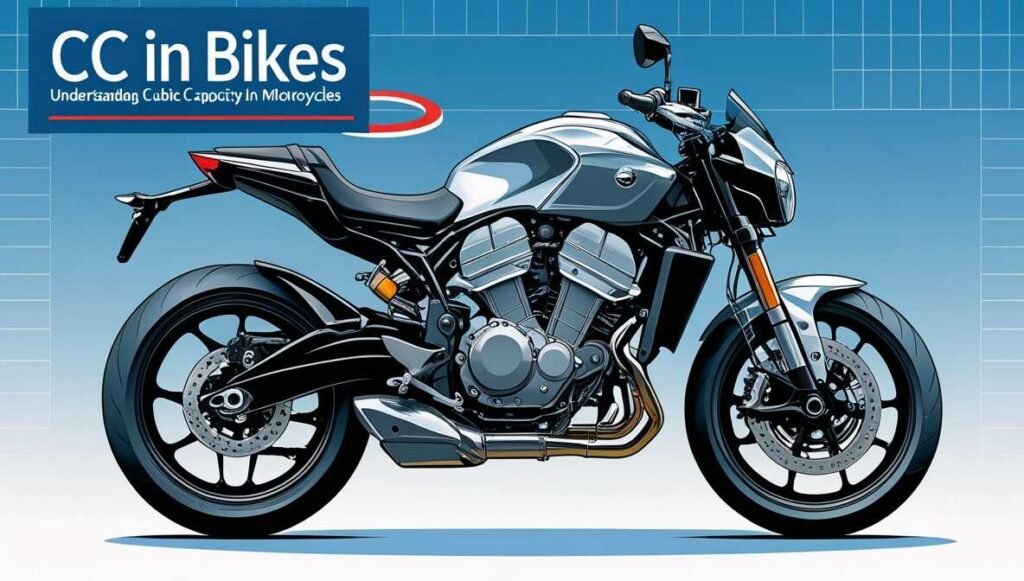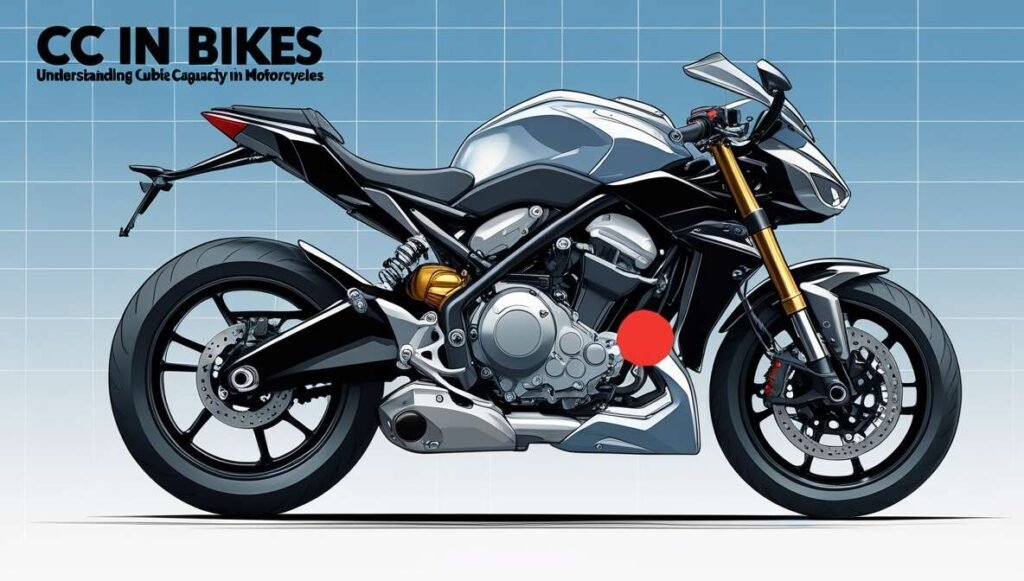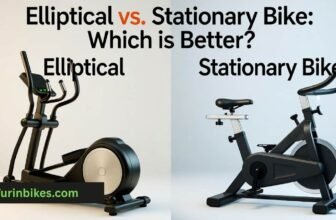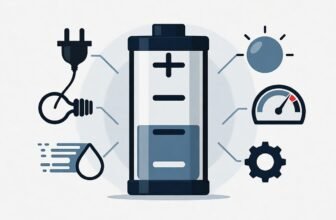
When it comes to motorcycles, you’ve probably heard terms like “150cc” or “500cc” thrown around. But what is CC in bikes, and why does it matter? Simply put, “CC” stands for Cubic Centimeters and refers to the engine displacement of a motorcycle. It represents the total volume of air and fuel that the engine’s cylinders can hold, playing a crucial role in determining the bike’s power, speed, and performance.
Understanding CC meaning in bikes is essential for bike enthusiasts, buyers, and riders alike. It helps in choosing the right motorcycle based on your needs, whether it’s a fuel-efficient commuter bike or a high-performance machine.
In this article, we’ll dive deeper into the concept of Cubic Capacity, explore how it impacts a motorcycle’s performance, and explain why it’s a key factor when deciding on the perfect ride. Let’s unravel the mystery of “CC” and what it means for your biking experience!

What Does CC Stand For in Bikes?
The term CC in bikes stands for Cubic Centimeters, which is a measurement of the engine’s displacement. In simple terms, it represents the volume of air and fuel mixture that the engine’s cylinders can hold during the combustion process.
Engine Displacement Explained
- Cubic Centimeters (CC): This is the total space inside all the cylinders of a motorcycle engine. For example, a 150cc engine can displace 150 cubic centimeters of the air-fuel mixture.
- Relation to Combustion: During each combustion cycle, the engine compresses a specific amount of air and fuel inside the cylinders. A larger CC value means the engine can combust more fuel-air mixture, producing more power.
Why CC Matters
- Power and Performance: A higher CC generally translates to greater engine power, better acceleration, and the ability to reach higher speeds.
- Efficiency and Suitability: Smaller engine displacement bikes, such as 100cc–150cc, are ideal for city commutes due to their fuel efficiency, while larger CC bikes, like 500cc or more, are perfect for long rides or racing.
CC Full Form in Bikes
The CC meaning in bikes is synonymous with the engine’s capacity to produce power and handle performance demands. It’s one of the most important factors to consider when choosing a motorcycle, as it directly influences your riding experience. Whether you’re looking for fuel efficiency or raw power, understanding the engine CC full form helps you make an informed decision.
How CC Affects Bike Performance
The CC and bike performance relationship is crucial for understanding how motorcycles function and what they are best suited for. The engine CC directly impacts a bike’s speed, power, and efficiency, making it an important consideration for buyers and riders.
1. Impact on Speed, Power, and Acceleration
- Higher CC = More Power and Speed
Bikes with higher engine displacement can combust a larger air-fuel mixture, producing more power. This results in faster acceleration, higher top speeds, and better performance. Litre class bikes (1,000cc+) are examples of high-performance motorcycles that dominate in speed and power. - Lower CC = Better Fuel Efficiency and Control
Bikes with smaller engines, such as 100cc–150cc models, consume less fuel, making them more efficient. They are ideal for city commutes and are easier to control, especially for beginners.
2. Examples of Bikes in Different CC Categories
- Small Bikes (50cc–150cc)
These bikes are lightweight, efficient, and easy to handle. Examples include the Honda Shine (125cc) and Hero Splendor (100cc). These are great for daily commuting. - Medium Bikes (200cc–500cc)
Medium-CC bikes strike a balance between performance and efficiency. They are versatile and can serve as comfortable bikes for long rides. Examples include the Royal Enfield Classic 350 (350cc) and KTM Duke 390 (373cc). - High-Performance Bikes (600cc+)
Bikes in this category, such as the Yamaha R1 (1,000cc) and Kawasaki Ninja H2 (998cc), are built for speed and power. These litre class bikes are perfect for racing and adrenaline-pumping adventures.
Highest CC Bike
The highest CC bike in the world is the Boss Hoss, featuring a V8 engine with a massive 6,200cc displacement. It’s a testament to how larger CC engines deliver unparalleled power and speed.
By understanding how CC and bike performance are interconnected, riders can choose a motorcycle that aligns with their needs—whether it’s a fuel-efficient commuter or a comfortable bike for long rides. The engine CC isn’t just a number; it’s a key factor that defines the entire riding experience.
Advantages and Disadvantages of Different CC Levels
When choosing between low CC vs high CC bikes, understanding the pros and cons of each category can help you select a motorcycle that matches your riding style, skill level, and needs. Here’s a breakdown of their advantages and disadvantages:
1. Low CC Bikes
Pros:
- Affordability: Low CC bikes (50cc–150cc) are budget-friendly, making them accessible for most riders.
- Fuel Efficiency: Smaller engines consume less fuel, making them ideal for cost-effective daily commutes.
- Ease of Handling: Lightweight and manageable, these bikes are perfect for beginners and city riding.
Cons:
- Limited Power: Low CC bikes lack the power required for high-speed cruising or overtaking on highways.
- Unsuitable for Long Rides: They may not provide the comfort or performance needed for extended trips.
2. High CC Bikes
Pros:
- Greater Speed and Power: High CC bikes (600cc and above) deliver superior performance, making them suitable for racing and highway travel.
- Versatility: They handle varied terrains better and are perfect for adrenaline-filled rides.
- Comfort for Long Rides: High CC bikes often come with features that make them more comfortable for extended journeys.
Cons:
- Higher Cost: High CC bikes are expensive, both in terms of purchase price and maintenance.
- Lower Fuel Efficiency: Larger engines consume more fuel, making them less economical.
- Skill Requirement: They demand greater riding experience and control, as mishandling can lead to accidents.
Low CC vs High CC Bikes: Making the Right Choice
The decision between low and high CC bikes boils down to your purpose:
- For city commutes or budget-conscious buyers, low CC bikes are the way to go.
- If you’re seeking performance, speed, and a bike suitable for racing or highways, the advantages of high CC bikes make them worth the investment.

Choosing the Right CC for Your Needs
Selecting the right engine CC is crucial for ensuring a motorcycle matches your requirements and riding style. Here’s a guide to help you decide based on key factors:
Factors to Consider
- Purpose
- Commuting: For daily city commutes, a low CC bike (100cc–150cc) offers great fuel efficiency and affordability.
- Touring: For long-distance rides, a medium CC bike (200cc–500cc) provides a balance of power and comfort.
- Racing: If speed and performance are your priorities, a high CC bike (600cc+) is ideal for adrenaline-filled adventures.
- Rider Experience
- Beginners: Low CC bikes are easier to handle and perfect for those just starting their riding journey.
- Experienced Riders: If you have the skills, a medium to high CC bike will offer more performance and thrill.
- Budget
- Higher CC bikes are generally more expensive, not only in terms of purchase price but also maintenance and fuel consumption. Determine your budget before deciding on the right bike engine for you.
Tips for First-Time Buyers
- Start small: Choose a bike with a manageable CC range (100cc–200cc) to build confidence and skills.
- Test ride: Always test ride a bike to ensure it feels comfortable and suits your riding style.
- Research thoroughly: Consider the bike’s weight, design, and features, as CC is only one part of the equation.
Common Myths About CC in Bikes
- Myth: Higher CC Always Means Better Performance
- Fact: While higher CC provides more power, other factors like bike weight, aerodynamics, and engine technology also significantly affect performance. A lighter 250cc bike can outperform a heavier 400cc bike in some situations.
- Myth: Low CC Bikes Are Only for Beginners
- Fact: Low CC bikes can also be ideal for experienced riders seeking affordable, fuel-efficient options for daily commuting.
- Myth: CC Alone Determines Speed
- Fact: Speed is influenced by a combination of CC, torque, gearing, and the bike’s overall design.
- Myth: All High CC Bikes Are Uncomfortable
- Fact: Many high CC bikes are designed for touring and offer excellent comfort for long rides.
By understanding these bike CC myths and considering factors like purpose, experience, and budget, you can confidently choose the right bike engine for you. Remember, CC is important, but it’s not the sole determinant of a bike’s suitability or performance.
Popular Bike Models by CC Range
Understanding bike categories based on engine displacement helps riders choose motorcycles tailored to their needs. Here’s a list of best bikes by CC across commuter, sports, and superbike categories, highlighting their features and ideal uses.
1. Commuter Bikes (50cc–150cc)
These bikes are designed for fuel efficiency, reliability, and ease of use, making them ideal for daily commutes.
- Hero Splendor Plus (100cc)
- Features: Lightweight, excellent mileage (~70 km/l), low maintenance.
- Use Case: Perfect for city commuting and first-time riders.
- Honda Shine (125cc)
- Features: Refined engine, smooth performance, good comfort.
- Use Case: A great option for urban and semi-urban commuters seeking reliability.
- Bajaj Pulsar 150 (149cc)
- Features: Sporty design, decent power, good mileage (~50 km/l).
- Use Case: Suited for commuters who want a mix of style and performance.
2. Sports Bikes (150cc–500cc)
This category focuses on performance, agility, and stylish designs, making them ideal for enthusiasts and weekend riders.
- Yamaha R15 V4 (155cc)
- Features: Aerodynamic design, VVA (Variable Valve Actuation) technology, sporty riding position.
- Use Case: Perfect for beginners exploring performance-oriented bikes.
- KTM Duke 390 (373cc)
- Features: Lightweight frame, powerful engine, ride-by-wire technology.
- Use Case: A thrilling ride for experienced riders, ideal for city and highway use.
- Royal Enfield Classic 350 (349cc)
- Features: Retro styling, torquey engine, comfortable ergonomics.
- Use Case: Best suited for relaxed highway cruising and long rides.
3. Superbikes (600cc and Above)
Built for high performance and speed, these bikes feature advanced engineering and are best for experienced riders.
- Kawasaki Ninja ZX-10R (998cc)
- Features: Track-ready design, 203 HP, advanced electronics package.
- Use Case: Ideal for racing enthusiasts and thrill-seekers.
- Ducati Panigale V4 (1103cc)
- Features: Italian engineering, aerodynamic design, high-performance engine.
- Use Case: Best for professional racers and experienced riders looking for top-tier performance.
- BMW S 1000 RR (999cc)
- Features: Cutting-edge aerodynamics, customizable ride modes, and sharp handling.
- Use Case: Designed for both the racetrack and high-speed road performance.
Meet Sachin Kumar, an avid cyclist and bike enthusiast with a passion for two-wheeled adventures. At our Turinbikes site, Sachin shares expert insights, thrilling ride experiences, and tips for fellow bike lovers.






